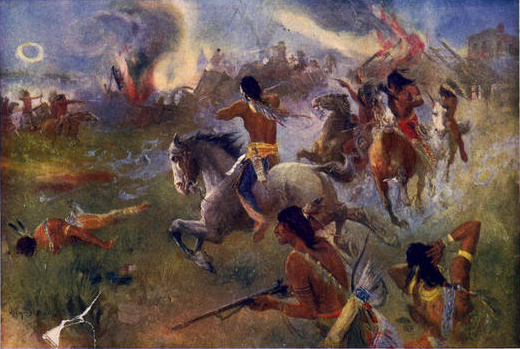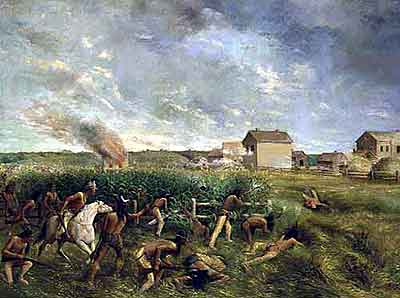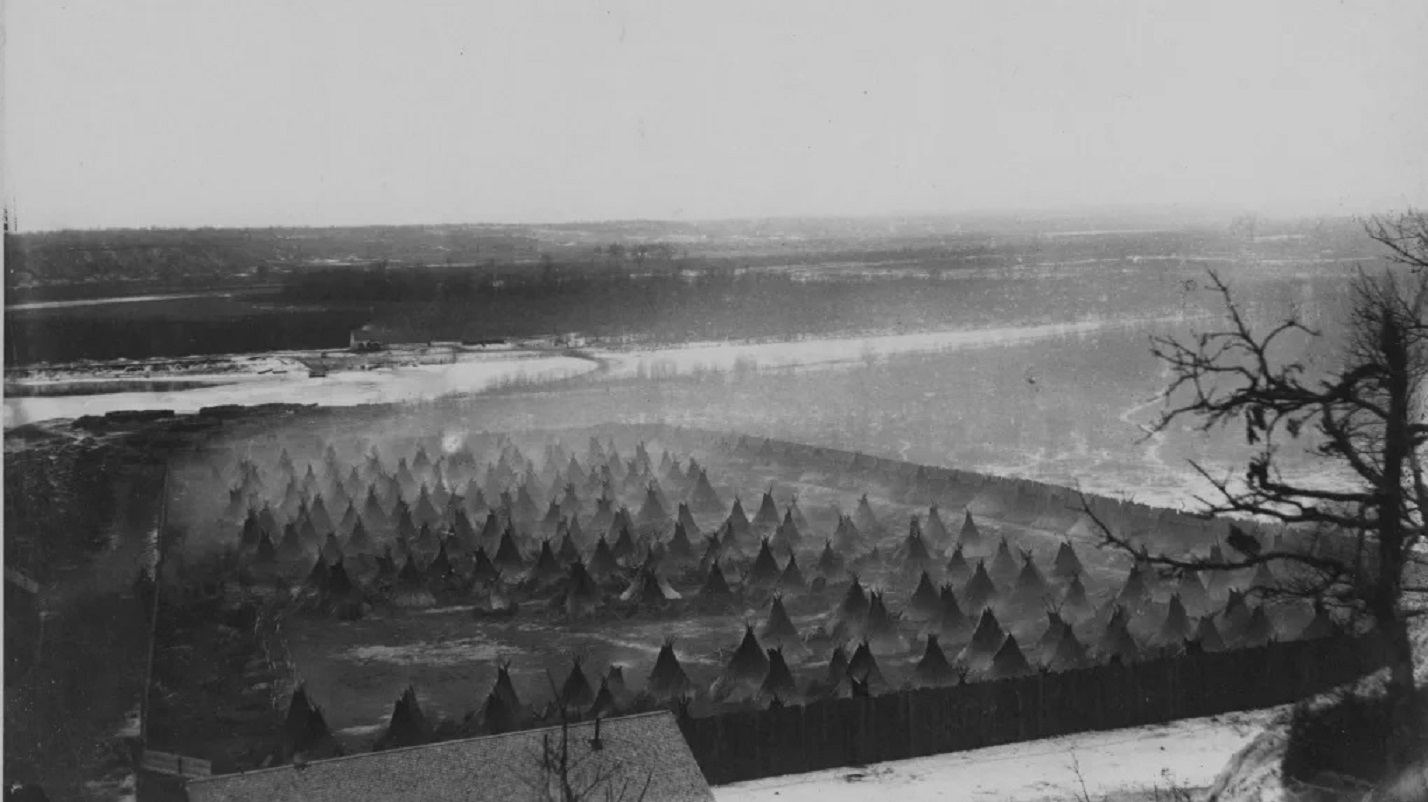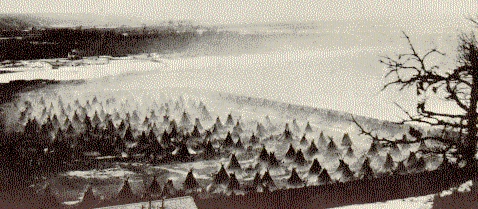Little Crow's village on the Mississippi by Capt. Seth Eastman, 1846.
His Red Nation: A Tale of Little Crow
Dakota Leader And The Struggle For Survival
By Jerome Kills SmallDakota Leader And The Struggle For Survival
GREAT PLAINS - Note: This was written for an issue of the North Dakota publication "On Second Thought" in 2012. Taoyate Duta, His Red Nation was born the winter that Little Beaver’s cabin burned down (1810), in the Dakota village of Kaposia, Not Encumbered With Much Baggage (St. Paul, MN), where the Minnesota and Mississippi Rivers converge. His Red Nation was named so by his father, a prominent Mdewakanton Dakota chief by the name of Cetan Wakhuwan Mani, Hawk Hunting Walks. Due to a mis-translation, and probably because of His Red Nation’s status as son to Hawk Hunting Walks, His Red Nation is more commonly recognized as Little Crow.
Little more than a toddler, His Red Nation's mother took him to the frozen Minnesota River in the middle of winter. There she broke the ice, took her son and proceeded to dunk him into the icy waters, and as she did so, she told him that he would grow into a man who would become a great leader. It sounds cruel, however, but His Red Nation never forgot his mother's words. Even as a man years later, he remembered what she did and as a result, what she said, as clearly as if it happened only yesterday.
His Red Nation, a pencil sketch by Frank Blackwell Mayer in 1851 at Traverse de Sioux, Minnesota Territory.
His Red Nation will forever be associated with the 1862 Minnesota Dakota Conflict, but the conflict was only the latest of terrible events. To understand the conflict and its consequences, one must examine the precarious circumstances in which the Eastern Dakota found themselves.
The Santee Dakota, or Eastern Sioux, had actively traded with the French and English since about 1640. The English pushed west, of what was considered then the Northwest Territory, or present-day Ohio. Colonel Robert Dickson, a British Trade Agent at the turn of 1800, became good friends with the Santee. His Red Nation was still a toddler when the War of 1812 broke out. Dickson recruited hundreds of Chippewa and Dakota and led them into Ohio to fight against Americans. Hawk Hunting Walks, was among those who fought for the English.
After the War of 1812, England and the United States signed the Treat of Ghent, ending warfare between the two countries. The treaty also gave control of Minnesota to the United States. The Santee would now have to deal with an unforgiving country they had initially fought against. Hawk Hunting Walks was honored with several gifts and accommodations from Colonel Dickson, but Hawk Hunting Walks refused them and was said to have kicked them, saying, “Now after we have fought for you, endured many hardships, lost some of our people, and awakened the vengeance of a powerful nation, our neighbours, you make a peace for yourselves, and leave us to get such terms as we can. You no longer need our services, and offer us these goods as a compensation for having deserted us. But, no-we will not take them; we hold them and yourselves in equal contempt.”
Traditional warfare between the Santee and Chippewa resumed regardless that they briefly fought alongside each other in the War of 1812. In 1823, Colonel Leavenworth led the Missouri Legion in a campaign against the Arikara on the Missouri River. About 750 Dakota and Lakota warriors fought for the United States under Leavenworth against an age-old foe in the first US led military campaign against a Plains Indian tribe. It was an absolute crushing defeat for the Arikara, who abandoned their earthlodge villages and fled west. Their fields of corn, squash, and beans, were plucked clean by the Dakota and Lakota who recalled the year as “The Winter Corn was Taken.”
"The year corn was taken," or 1823, from the Long Soldier Winter Count.
Hawk Hunting Walks’ image was painted by Charles King Bird on a visit to President James Monroe in 1824. Monroe congratulated the Sioux for their participation in breaking the Arikara out west, this, as sentiment grew in DC that Indians should all be moved west of the Mississippi River. Hawk Hunting Walks returned to Minnesota, perhaps a little wary, and signed the Treaty of Prairie Du Chien of 1825 under the watchful eye of General William Clark, former captain of the Corps of Discovery. The treaty formalized tribal territories and sought to end generations of inter-tribal conflict.
In 1830, General Clark brought several bands of Sioux together to sign another Treaty of Prairie Du Chien, which ceded three large tracts of land to the United States for westward expansion into Minnesota. It was a treaty that the Dakota were hard-pressed to keep.
Little Crow, photo by Whitney, 1862.
The Sioux, Dakota and Lakota, had other concerns throughout the 1830s and 1840s. There was warfare with the Crow, Arikara, Pawnee, and Shoshone west of the Missouri River, and continuing warfare with the Chippewa up north. Smallpox took the lives of thousands of Indians across the Plains. A massive star fall is remembered in nearly all winter counts. In 1846, Hawk Hunting Walks had a gun mishap in which he accidentally shot himself and died.
Chieftanship of the Mdewakanton Dakota, whom Hawk Hunting Walks led, was in dispute. Hawk Hunting Walks had children with three wives. His Red Nation’s mother was a Wahpekute Dakota, and so his brothers from his father’s other wives conspired to keep the chieftanship within the Mdewakanton. All of Hawk Hunting Walks’ sons met at a tribal get together. His Red Nation’s brothers attempted to assassinate him, at the last moment however, a young man knocked the gun with his hatchet causing the bullet to strike His Red Nation in the arm, breaking it – it was never set properly and healed crookedly, and left an awful scar. The conspiring brothers were condemned to death and His Red Nation became the chief.
"Execution Of The Thirty Eight Sioux Indians" by John C Wise.
As a boy, His Red Nation engaged in sham fights to learn stealth and leadership. To gain a victory in a sham fight, a mock war party had to take the village by surprise, or it wasn’t a victory at all. When he was ten, His Red Nation took his village by surprise when he crept into it unseen with the aid of his dog. A few years later, a friend of his fell through the ice and His Red Nation risked his own life to save him with a line. He fell through the ice as well, but managed to save his friend. His Red Nation became known in his youth as a trusty messenger and a great hunter.
In 1851, after years of preparation, the untimely death of his father, and an attempt on his life, His Red Nation received his first test in American bureaucracy at the Treaty of Traverse De Sioux in which the southern half of Minnesota was ceded to the United States, and the Treaty of Mendota, in which permanent agencies were established for the Dakota in Minnesota. The Dakota were to receive payments for their land cession, and food supplements while they adjusted to a completely sedentary lifestyle.
"Mass Execution of 38 Dakota on the Day After Christmas" By John Stevens.
His Red Nation tried his best to placate the settlers and new Minnesota government by adopting the white man’s clothes. He also converted to Christianity and became an Episcopalian. His Red Nation even took up farming. In his best efforts to ensure peace in his homeland, which had become an island in the middle of non-native settlement, in 1860 His Red Nation went east to visit with President James Buchanan to remind him that the Dakota fought for the US under Leavenworth and had willingly signed and followed treaty stipulation.
The United States had other concerns. The Civil War.
Sibley-Indian-Expedition, Harpers Weekly 1863.
By 1862, the Civil War was drawing on all the resources of the states from able men to fields of crops. The Indian agents and traders were suddenly faced with little supervision in their work and as the saying goes, “Absolute power corrupts absolutely.” Indian agents in Minnesota were selling their wards food, supplies and seed when it was supposed to have been distributed according to treaty. Meanwhile, a combination of drought, disease and infestation nearly put an end to the growing season leaving little to harvest. The Dakota began to starve while warehouses stood full. The situation became desperate and in bad times the only choices left are bad choices.
His Red Nation could not reassure his people, ease their anxiety, or feed them and his ability to restrain his people weakened.
"The Siege of New Ulm, Minn.", a painting by Henry August Schwabe. Schwab depicts an attack on New Ulm on August 19, during the Dakota War of 1862.
On August 4, 1862, a desperate and hungry party of Dakota men broke into the food warehouse at the Lower Agency on the Minnesota River. The Indian Agent, Thomas Galbraith, ordered the soldiers under his command not to fire and immediately called for a council with His Red Nation and his people. At this hastily called council, His Red Nation reminded Galbraith that the Dakota were owed money to buy food and supplies and warned the agent that “when men are hungry, they help themselves.” A representative of the traders, Andrew Myrick, smartly retorted, “So far as I am concerned, if they are hungry let them eat grass or their own dung."
With hunger abated for the moment, the Dakota returned home. A few days later, August, 17, five Dakota men were returning from an unsuccessful hunt and goaded one another to steal from a farmer on their return home. The theft turned into a gunfight which left five settlers dead. The hunters returned home and told of their exploit which rattled the Dakota community. Some were for turning in the five hunters, others were for outright war. His Red Nation was for keeping the peace but he was still their chief, and when an overwhelming number of his people wanted to fight, he reluctantly prepared for war.
"Attack on New Ulm during the Sioux Outbreak, Aug. 19-23, 1862," by Anton Gag, 1904.
His Red Nation led the war party to Myrick’s house. They killed Myrick and then stuffed his mouth with grass for his cutting words. His Red Nation led them on a campaign along the Minnesota River with victories at New Ulm, which they burned to the ground, but only a month into their campaign against the settlers and soldiers, His Red Nation took a severe defeat in the Battle of Wood Lake, September 23. The defeat was such that His Red Nation broke for Canada. Men who fought under his leadership in a war he did not want to fight, either fled for Canada as well, or journeyed west to Dakota Territory to live among their Teton relatives.
Internment camp at Pike Island on the Minnesota River below Fort Snelling, Minnesota by Benjamin Franklin Upton, 1862.
The Dakota who surrendered after the Battle of Wood Lake were taken to Mankato, MN. There, 303 Dakota men were convicted of murder and rape. The trials for many lasted five minutes or less. No one explained the proceedings, nor were any Dakota men represented. President Abraham Lincoln personally reviewed each case and commuted the death sentence of 264 of the Dakota men, and ordered thirty-nine to hang in the largest mass execution in US history on December 26, 1862. On January 1, 1863, just one week later, President Lincoln issued the Emancipation Proclamation.
Condemned prisoners in prison at Mankato, MN, 1862.
According to Kills Small, His Red Nation spent the winter and spring petitioning the Teton Lakota, petitioning even the Arikara, the Hidatsa, and the Mandan Indians to take up arms against the whites. The Teton Lakota had other concerns with warfare on other tribes, and defending their own lands. The Arikara, Hidatsa, and Mandan were too few and did not have the strength nor heart to take up arms against a country that they depended on since the last smallpox epidemic.
The following summer, His Red Nation decided to risk a return to Minnesota with his seventeen year-old son, Wowinape, Haven or Sanctuary but often translated as Place Of Refuge. His Red Nation and Haven decided to stop in a farmer’s field to gather raspberries. The farmer, Nathan Lamson, and his son engaged His Red Nation and Haven mortally wounding His Red Nation. His Red Nation shot and wounded Lamson. His Red Nation told his son to run, even as Lamson’s son ran to get help.
A Yanktonai Dakota camp is being invaded by Sully's brigade during the Dakota Wars at the Battle of White Stone Hill, North Dakota, September 3, 1863, Harper's Weekly, Oct. 31, 1863, p. 693. Killing and mutilating His Red Nation's body wasn't enough. General Sully was called in to attack a group of Sioux who had nothing to do with the 1862 conflict.
Lamson’s son ran about twelve miles to Hutchinson, MN, and returned with a posse. At first the posse didn’t recognize that the dead Dakota man was His Red Nation, but as realization dawned on them that they had the body of “Little Crow,” they mutilated his body, brought it back to Hutchinson where they dragged it down Main Street. The citizens placed firecrackers in the body’s ears and allowed their dogs to chew on the body, which was tossed in an alley where refuse was typically discarded.
The 8th Minn Infantry, again led by General Sully. This time, Sully and his command attacked an encampment of Teton Lakota who were led by Chiefs Sitting Bull and Gall. As was the case this time around as it was at Whitestone Hill, this group of Sioux had nothing to do with what happened in Minnesota, 1862. Painting by Carl Ludwig Boeckmann.
Haven ran to Spirit Lake, Dakota Territory. He was captured around Fort Totten, tried and sentenced to hang. Haven was sent to prison in Davenport, Iowa. There, he converted to Christianity and took the name Thomas Wakeman. He was pardoned in 1865, after the Civil War, and settled in Dakota Territory.
In 1971, His Red Nation’s remains were returned to Jesse Wakeman, Haven’s son, for internment.
Jerome Kills Small, Sisoka (Robin) pictured here. Image from his CD Inikagapi.
Jerome Kills Small, Sisoka (Red Robin) is an Oglala Lakota from Pine Ridge, SD. Kills Small is the recipient of the Distinguished Scholar Award from the South Dakota Humanities Council, a Reconciliation Award from the Governor of SD, George Nickleson, and was selected by the University of South Dakota as the Poet of the Year in 1994. Kills Small has portrayed Tecumseh and Dr. Charles Eastman in the Chautauqua venue across the country. He is a traditional singer and storyteller. Kills Small can be heard on the CD "Inikagapi." Support a native author, storyteller, poet, and singer. Get your copy on Amazon or whatever.
















No comments:
Post a Comment